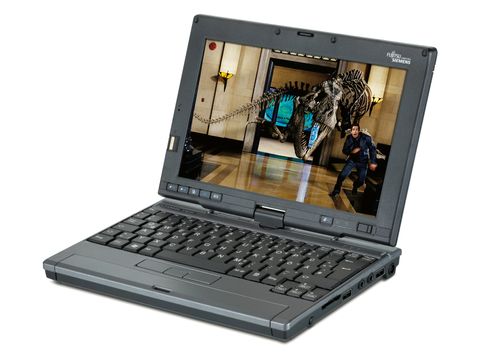TechRadar Verdict
An interesting addition to the Tablet PC ranks, but it loses points in a couple of key areas
Pros
- +
HSDPA support
Highly portable
Cons
- -
Disappointing battery life
Only mid-range processing power
Why you can trust TechRadar
Tablet PCs haven't set the consumer world alight, but in business and education circuits they've become something of a mainstay.
After all, while the average person may not need to brainstorm or collaborate with others, Tablet PCs allow you to do this easily. You can scribble a note and then either convert it to text, or if it's a sketch simply save it in all it's rushed glory and email it to a colleague for their input.
Slimline design
One of the problems with most Tablets has been the rather large design, the thinking being that most users want a screen matching that of an A4 sheet of paper.
The screen on the Fujitsu Siemens Lifebook P1610 (£1465 inc. VAT) is more the size of an A5 sheet, courtesy of the 8.9-inch digitised display. It's a reasonable size, but we felt that any smaller and it would be too small as you really need to angle it just right to get the best of the screen when using it in laptop mode. When you're using it as a tablet, the lack of screen means you have to draw and write smaller, but it's a compromise worth making for the compact size.
All this means the weight of 990g, makes this the smallest and lightest Tablet PC on offer. If you really need a machine that is lightweight and portable, this is one to check out.
Along with the compact size there are a number of features that help this machine stand out. Biometric fingerprint scanners are common enough on the latest business laptops but built-in 3G, supporting HSDPA, is still something waiting to catch on. Suddenly, the notes you wrote in the meeting away from the office can be sent for instant approval.
It's powered by an Intel Pentium M U1400 processor. This is an ultra-low voltage chip designed for prolonging battery life rather than for sheer performance, so this isn't the most powerful machine on the market. Even so, we found a degree of heat build-up on the underside of the chassis which became a little uncomfortable. When it came to battery life, we managed to get 171 minutes, under test, which is far from ideal and lets down the mobile nature of the Tablet PC.
Further bad news is the lack of an optical drive and, while the Lifebook comes with a docking station, this duplicates the tablets features and lacks an optical drive.
The Fujitsu Siemens Lifebook P1610 isn't designed for the average user; it's for the business person who needs that little bit extra, and on this level it certainly delivers. However, we feel that it's best used as a secondary machine, for meetings and the like, and not as your sole PC.
Tech.co.uk was the former name of TechRadar.com. Its staff were at the forefront of the digital publishing revolution, and spearheaded the move to bring consumer technology journalism to its natural home – online. Many of the current TechRadar staff started life a Tech.co.uk staff writer, covering everything from the emerging smartphone market to the evolving market of personal computers. Think of it as the building blocks of the TechRadar you love today.

